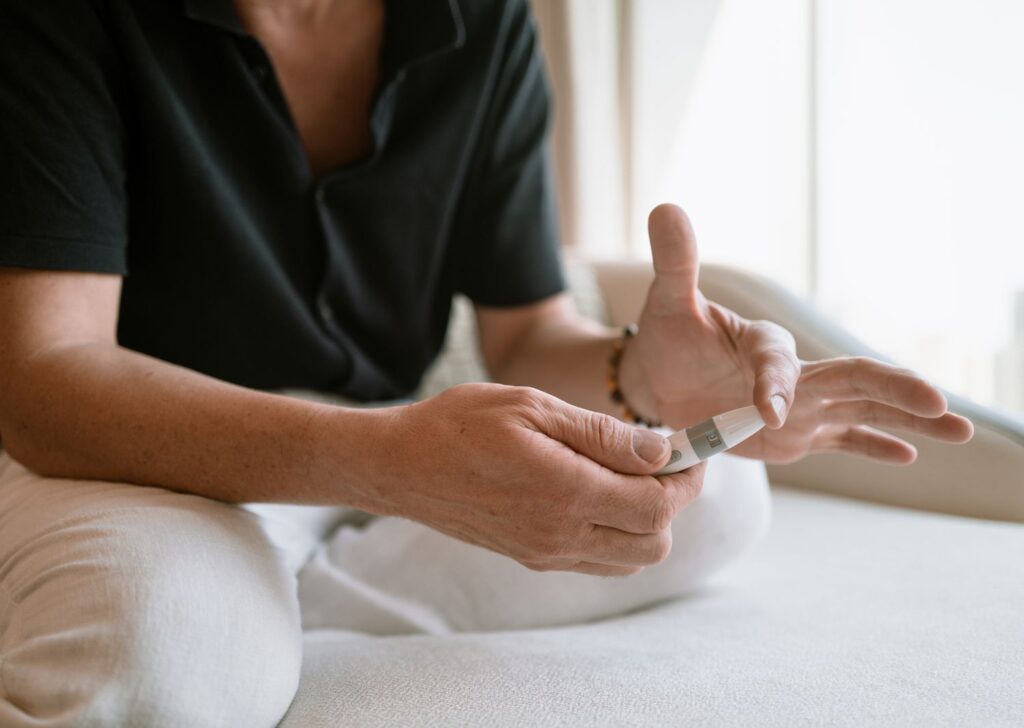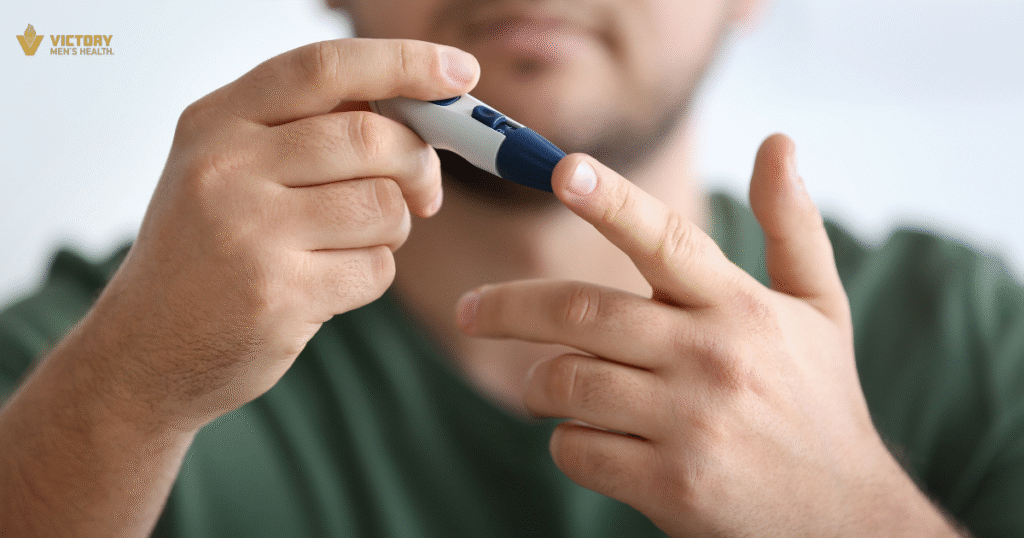
Testosterone testing at home is becoming popular, especially among older adults who want an easier way to monitor their health. This type of testing lets you check your hormone levels from the comfort of home. You no longer need to visit a lab or schedule a doctor’s appointment for simple hormone checks. More people are choosing home testing because it is private, saves time, and puts you in control of your health.
As we age, testosterone levels often decline, which can affect energy, mood, and strength. Being able to track this important hormone at home is a step forward in making healthcare more accessible and personal. Reliable home testing kits are now available, giving accurate results when used correctly. Below, you will find everything you need to know to make an informed decision about home testosterone testing.
Understanding Testosterone Testing At Home

At-home testosterone testing allows you to measure the levels of testosterone in your body without having to visit a clinic or laboratory. You order a test kit online or at a pharmacy, collect your sample at home, and then send it to a certified laboratory for analysis.
Traditional lab testing usually requires a doctor’s order, a scheduled appointment, and blood drawn from a vein by a professional. Home testing uses saliva, finger-prick blood, or urine, which is less invasive and more convenient. The process can be completed in your own home and often costs less than in-clinic testing.
Home testosterone tests are suitable for older adults experiencing symptoms such as tiredness, low sex drive, changes in mood, or muscle loss. They are also helpful for men on hormone therapy who need to monitor their levels regularly. Home tests are not meant to replace all doctor visits but can be a useful first step or regular check between appointments.
Types of At-Home Testosterone Tests
Understanding the different types of home tests helps you choose the right one. Here is an easy guide to each method.
- Saliva-Based Tests : These tests involve collecting your saliva, usually by spitting into a tube or using a swab. They are simple to use and painless. Saliva tests mainly measure “free” testosterone, which is the active form available to the body. This method is less stressful, especially for those uncomfortable with needles.
- Finger-Prick Blood Tests : This test uses a small lancet to prick your finger and collect a few drops of blood. The sample is placed on a special card or in a vial and sent to a lab. Blood tests can measure both total and free testosterone levels. This method is widely considered reliable and is the closest at-home option to standard lab testing.
- Urine-Based Tests : You collect urine, usually over several hours or throughout a day. These tests look for testosterone and its by-products. Urine tests can show hormone patterns over time and are sometimes used as part of a broader hormone panel. They can help identify trends rather than give a single snapshot.
- Key Differences and Accuracy Comparison : Each type of test has its own benefits and limitations. Blood tests are generally considered the most accurate for measuring testosterone. Saliva is best for monitoring changes over time and is easy to use. Urine tests provide more detail about how hormones are used by your body. Accuracy depends on following instructions and the quality of the lab analyzing your sample.
How Home Testosterone Testing Works: Step-by-Step
At-home testing kits are designed to be user-friendly. Knowing the steps ahead of time helps ensure the process is smooth and your results are reliable. Before starting, make sure to read all instructions that come with your kit.

- Ordering a Kit : You can order a test kit online from reputable health brands or pick one up at a local pharmacy. Make sure the kit comes from a certified lab.
- Receiving and Preparing the Kit : Once your kit arrives, open it and review all included materials. Wash your hands and set up a clean workspace. Read through the instructions completely to avoid mistakes.
- Sample Collection Process : The process may vary based on the test type. For saliva, avoid eating, drinking, or brushing teeth 30 minutes before collection. For blood, clean your finger with an alcohol swab, prick it with the lancet, and collect the required drops. For urine, follow the timing instructions carefully, sometimes collecting samples at different times of the day.
- Time of Day : Testosterone is usually highest in the morning. For best results, collect your sample between 7 and 10 am, unless the kit specifies otherwise.
- Preparation Steps : Be sure to avoid strenuous exercise, caffeine, and certain medications before your test, as these can affect results. Follow all preparation instructions exactly.
- Packaging and Sending the Sample : Seal your sample in the containers provided. Complete any required forms, including your details and the date of collection. Use the prepaid mailer to send your sample to the lab as soon as possible.
- Result Processing Timeline : Labs typically process your sample within 2 to 5 days after receiving it. Results are sent by email or made available in a secure online portal. Some kits include a summary to help you understand your numbers.
Convenience and Advantages of At-Home Testing
Testing at home has made it easier for older adults to stay on top of their hormone health. Here are the main advantages explained in simple terms.
- Privacy and Discretion
No one else needs to know you are getting tested. There is no need to explain your visit to anyone, and all results are confidential. - Time Savings
You avoid scheduling appointments, waiting rooms, and trips to the clinic. The whole process can be done on your own schedule, often in less than 30 minutes. - Accessibility for Remote Locations
For those living far from medical facilities, home testing removes the need to travel long distances. Kits can be delivered almost anywhere. - No Need for Doctor Visits
You do not have to wait for a doctor’s referral or spend time in a clinic. However, always share your results with your healthcare provider if you have any concerns.
Accuracy and Reliability: What You Need to Know
Accuracy is a top concern when testing at home. This table explains what affects reliability and how at-home kits compare to traditional lab tests. Before reviewing the table, remember that using a high-quality kit and carefully following instructions improves your chances of accurate results.
| Factor | Home Testing | In-Clinic Testing | Details |
| Clinical Validation | Some kits validated by clinical studies | Standard clinical validation | Check for CLIA or CAP certification |
| Common Sources of Error | User mistakes in sample collection or storage | Professional sample handling | Errors more likely at home |
| Comparison to In-Clinic | Accurate for most, especially with blood test kits | Considered gold standard | Blood tests most reliable at home |
| How to Interpret Results | Results often include clear explanations or guides | Doctor explains during appointment | Home kits may offer digital support |
| Quality Control Measures | Leading brands follow strict lab protocols | Strict clinical and lab procedures | Choose brands with strong lab credentials |
Choosing the Right At-Home Testosterone Test Kit
Selecting the right kit is important for getting trustworthy results. Here is what to consider before purchasing:
- What to Look For in a Test Kit: Make sure the kit is easy to use, has clear instructions, and covers the specific hormone tests you need.
- Reputable Brands and Labs: Choose brands with positive reviews and established reputations. Some trusted names include Everlywell, LetsGetChecked, and Verisana.
- Certifications and Accreditations: Look for CLIA (Clinical Laboratory Improvement Amendments) or CAP (College of American Pathologists) certification on the lab processing your sample.
- Price Range and What’s Included: Kits typically range from $50 to $120. The price should include everything needed for collection, prepaid shipping, and online access to results.
- Customer Reviews and Ratings: Read feedback from other users about ease of use, result clarity, and customer service.
When and How Often Should You Test Your Testosterone?
Testing at the right time and frequency is important for getting useful information. Here is what you need to know before deciding when to test.
- Signs and Symptoms to Watch For: Fatigue, low sex drive, mood swings, memory problems, loss of strength, and weight gain can all point to low testosterone.
- Recommended Testing Frequency: If you have symptoms, start with a baseline test, then repeat every 3 to 6 months or as recommended by your doctor. Those on testosterone therapy may need more frequent checks.
- Best Time of Day for Accurate Results: Early morning, between 7 and 10 am, is ideal since testosterone is at its peak.
Cost Breakdown: At-Home vs. Traditional Lab Testing
Cost is often a deciding factor when choosing between home and lab testing. Here are the details to help you plan:
- Typical Pricing: Home kits usually cost $50 to $120 per test. In-clinic tests can range from $100 to $250 or more, depending on where you live.
- Insurance Coverage: Many home kits qualify for payment with Health Savings Accounts (HSA) or Flexible Spending Accounts (FSA). Regular health insurance may not cover at-home testing.
- Value Assessment: Home testing is more affordable, saves time, and allows frequent monitoring, making it a good choice for those who need regular checks.
The Future of At-Home Hormone Testing
At-home hormone testing is evolving quickly, offering new possibilities for personalized health monitoring. Innovations in this field are making it easier than ever to track hormone levels with improved accuracy and convenience. Future home test kits are expected to measure a wider range of hormones, going beyond just testosterone to include estrogen, cortisol, thyroid hormones, and more.
Digital tracking is becoming a key feature, allowing users to monitor changes over time and receive personalized insights on their health trends through user-friendly apps. Many testing companies are now integrating telemedicine services, so users can share results instantly with healthcare providers and receive expert advice or treatment plans from home. These advancements not only increase accessibility for those in remote locations but also empower individuals to take a proactive approach to their hormone health. The future promises even greater reliability, privacy, and connection between patients and healthcare professionals.
Conclusion
At-home testosterone testing offers older adults a practical and reliable way to keep track of their hormone health without visiting a clinic. These tests allow you to check your testosterone levels easily from home, helping you notice any changes early and make informed health decisions. With high-quality kits and careful sample collection, home tests can provide results that are nearly as accurate as lab tests.
This convenience is especially valuable for those in remote areas or with busy schedules. However, home tests are not a replacement for medical advice. If your results are outside the normal range or if you have ongoing symptoms, always share your results with your healthcare provider to ensure you get the right care and support for your health needs.
Frequently Asked Questions (FAQs)
How accurate are at-home testosterone tests compared to lab tests?
At-home finger-prick blood tests, when processed by accredited labs, are nearly as accurate as lab tests, though proper sample collection is essential for reliable results.
Which is better: saliva, blood, or urine testosterone testing at home?
Blood tests provide the most accurate results. Saliva tests are useful for tracking trends, while urine tests help show hormone patterns over time but are less precise for diagnosis.
Can at-home testosterone tests diagnose testosterone deficiency?
Home tests can detect low testosterone levels, but a healthcare provider should confirm the diagnosis and determine treatment based on additional lab testing and a clinical evaluation.
How soon do I get results from a home testosterone test?
Results from most home testosterone tests are available within 2 to 5 days after the laboratory receives your sample, with online access or email notifications provided.
Are at-home testosterone test results accepted by doctors?
Doctors may review results from reputable at-home test kits, but they often require confirmation through additional blood testing done in a clinical laboratory for accurate diagnosis.
What can cause inaccurate results in home testosterone testing?
Inaccurate results can occur from improper sample collection, not following instructions, contamination, medication interference, or using non-accredited kits. Always follow the kit’s guidelines closely.
How often should men test their testosterone at home?
Men should test every 3 to 6 months if they have symptoms or are on testosterone therapy. Frequency may vary based on medical advice or changes in symptoms.
What are the best at-home testosterone test kits?
Leading kits include Everlywell, LetsGetChecked, and Verisana. Choose kits processed by accredited labs with clear instructions and good customer support for the best results.
Do at-home testosterone test kits check for other hormones?
Many at-home testosterone kits also offer options to check for additional hormones, including DHEA, estradiol, or cortisol, depending on the provider and test package.
Is it safe to rely solely on home testosterone test results?
No, always use home test results as a monitoring tool. Discuss any abnormal results with your healthcare provider before making health or treatment decisions.
References
- https://www.mayoclinic.org/tests-procedures/testosterone-test/about/pac-20385099
- https://www.urologyhealth.org/urology-a-z/t/testosterone-testing-and-replacement
- https://www.letsgetchecked.com/articles/how-accurate-are-at-home-testosterone-tests
- https://www.everlywell.com/products/testosterone-test
- https://www.auanet.org/guidelines/guidelines/testosterone-deficiency-guideline
- https://www.verisana.com/us/at-home-hormone-tests
- https://www.webmd.com/men/features/at-home-testosterone-tests
Aubrey Carson is an RDN with 9 years across hospital, outpatient, and private practice settings. They earned an MS in Clinical Nutrition from Tufts University – Friedman School (2016) and completed a Dietetic Internship at Mayo Clinic. Aubrey specializes in micronutrient assessment, evidence-based supplementation, and patient education. Their work includes CE presentations for the Academy of Nutrition and Dietetics and collaborations with Mass General Brigham on nutrition education resources.

